When choosing darkfield objectives, prioritize numerical apertures above 1.0 for high magnifications, with oil immersion for 60X and 100X. Match your working distance to vessel thickness—standard objectives work with 0.17mm coverslips, while thicker vessels need LWD objectives. Consider apochromatic lenses for superior aberration correction in research applications, though they’re pricier than achromatic options. Always verify your condenser NA matches or exceeds your objective specifications for ideal contrast. Discover how proper objective selection transforms your darkfield imaging results.
Understanding Numerical Aperture Requirements for Darkfield Imaging
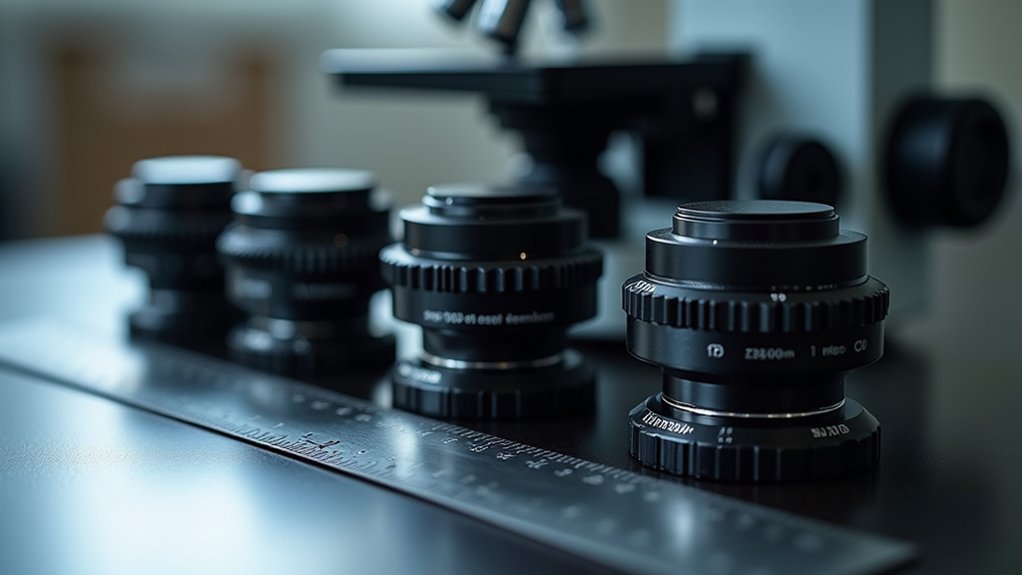
When selecting objectives for darkfield microscopy, numerical aperture (NA) serves as the critical parameter that determines your imaging success.
You’ll need objectives with NA values greater than 1.0 for high magnification work, ensuring ideal capture of refracted light from your specimens.
For 60X and 100X high magnification objectives, you’ll require oil immersion techniques to maximize light transmission and achieve superior image quality.
Remember that the NA directly impacts your resolving power—higher values enable visualization of minute structures like bacterial flagella.
Higher NA values reveal microscopic wonders like bacterial flagella that remain hidden to less powerful objectives.
Your condenser’s NA must match or exceed your objective’s specifications to maintain proper light pathways.
This balance enhances clarity while controlling depth of field, allowing you to resolve fine details that would otherwise remain invisible in conventional microscopy.
Critical Considerations for Working Distance in Darkfield Objectives
Although often overlooked, working distance represents an essential factor in selecting appropriate darkfield objectives for your microscopy needs. High numerical aperture darkfield objectives typically feature shorter working distances, requiring precise alignment to prevent specimen damage while guaranteeing ideal light collection.
You’ll need to balance your application requirements against working distance constraints. For thicker samples or specimens in plastic vessels, consider long-working distance (LWD) objectives that provide better clearance from slides or cover slips. These typically range from 0.2 mm to 1.2 mm depending on your specimen type.
Remember to account for your condenser setup when choosing objectives. Maintain sufficient working distance to accommodate your darkfield condenser and prevent interference from the light source. This guarantees proper illumination while protecting both your specimen and equipment.
Matching Objective Specifications to Sample Vessel Thickness
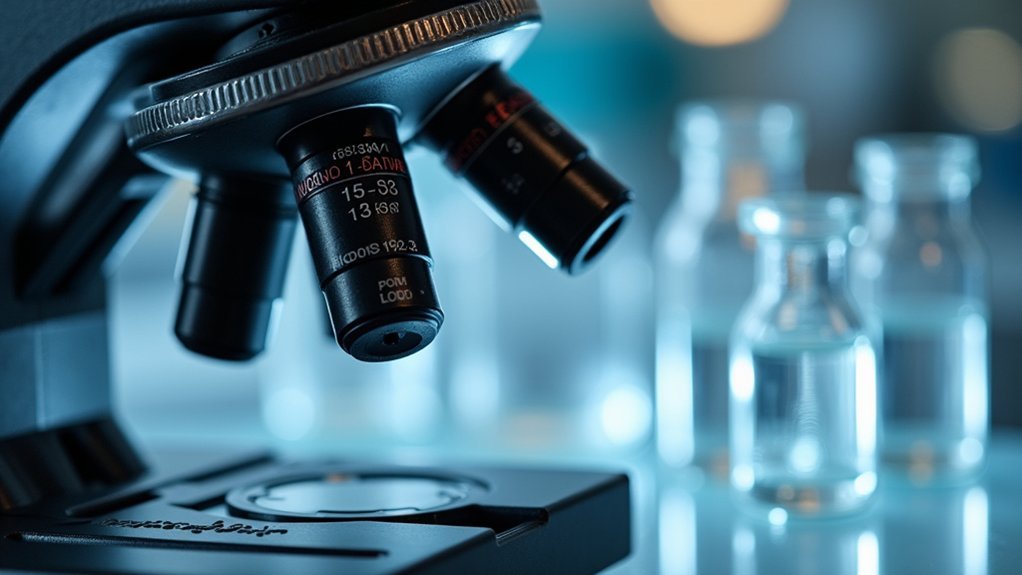
When choosing darkfield objectives, you’ll need to match the numerical aperture (NA) to your vessel thickness, with standard objectives requiring the 0.17 mm coverslips for ideal performance.
For thicker sample containers like plastic dishes or flasks, select long-working distance (LWD) objectives that can accommodate thicknesses greater than 0.8 mm without compromising image clarity.
Remember that using objectives specifically designed for your vessel type (such as those marked ∞/1.0 mm for coverslips) will greatly enhance your image quality and reveal finer structural details.
Cover Glass Compatibility
The success of darkfield microscopy largely depends on matching your objective specifications to the thickness of your sample vessel.
Standard objectives are designed for 0.17 mm cover glass thickness, while specialized objectives marked ∞/1.0 mm accommodate plastic vessels. You’ll need to verify compatibility to avoid distortion and maintain image clarity.
For best imaging results:
- Select high NA objectives that match your vessel thickness, as improper alignment leads to blurry images.
- Consider LWD objectives for thicker substrates, verifying proper working distance during observation.
- Conduct empirical testing with your specific vessels to determine the ideal objective specifications.
Remember that cover glass thickness correction is critical when working with specialized darkfield microscopy setups, particularly when dealing with samples that require precise focus and contrast.
Working Distance Requirements
Successful darkfield imaging depends critically on matching your objective’s working distance to your sample vessel thickness.
For high magnifications (40x, 60x), this compatibility becomes even more essential for clear imaging.
When working with thicker substrates (≥0.8 mm) like plastic dishes or flasks, you’ll need long-working distance (LWD) objectives specifically designed for these applications.
Conversely, if you’re imaging samples under coverslips, opt for coverslip-corrected (CC) objectives, which are tailored for an ideal vessel thickness of 0.17 mm.
Avoid using LWD objectives for coverslip imaging—this mismatch will produce less than optimal results and blurry images.
When uncertain about your vessel’s actual thickness, empirical determination through measurement can greatly enhance your objective selection, ensuring you achieve the exceptional clarity darkfield microscopy can deliver.
Correcting for Thickness
Correcting for vessel thickness represents one of the most critical yet frequently overlooked aspects of darkfield microscopy. Your dark-field objectives must precisely match your vessel thickness for ideal image clarity and resolution.
Standard microscope slides require objectives calibrated for 0.17mm coverslips, while thicker vessels need long working distance (LWD) objectives.
When selecting objectives, consider these thickness-matching requirements:
- Numerical aperture compatibility – Higher NA objectives deliver superior resolution but require precise thickness matching.
- Working distance requirements – Thicker vessels (≥0.8mm) demand LWD objectives marked with ∞/1.0 or ∞/1.2mm specifications.
- Empirical verification – Always measure your actual vessel thickness before selecting objectives, as manufacturer specifications may vary.
Mismatched thickness-objective pairings inevitably produce blurry images, regardless of your microscope’s quality or illumination settings.
Selecting Between Achromatic and Apochromatic Darkfield Objectives
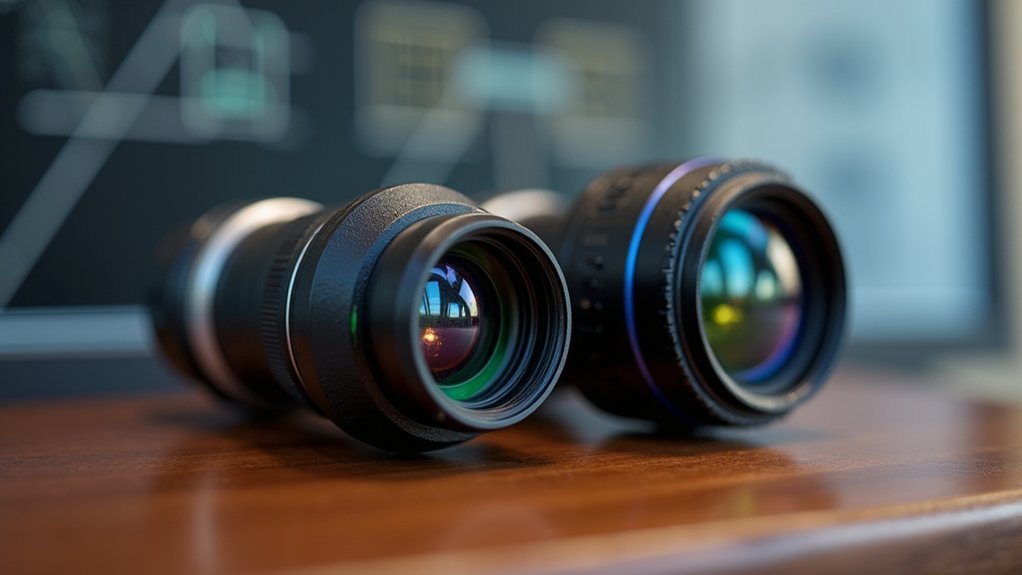
When choosing between darkfield objective types, you’ll need to weigh how chromatic aberration correction affects your imaging quality, with achromatics correcting at two wavelengths while apochromatics handle three or more.
Your budget will influence this decision, as apochromatic objectives cost more but deliver superior resolution and color fidelity that often justifies the investment for detail-critical work.
Consider your specific application requirements carefully—achromatics work well for general observations, while apochromatics are essential for high-precision research requiring exceptional color accuracy in unstained specimens.
Chromatic Aberration Correction
The selection between achromatic and apochromatic darkfield objectives represents an essential decision in microscopy that directly affects image quality and experimental outcomes.
Achromatic darkfield objectives correct chromatic aberration for two wavelengths (red and blue), making them suitable for routine applications, while apochromatic objectives correct for three to five wavelengths, delivering superior color fidelity vital for fluorescence microscopy.
When evaluating chromatic aberration correction, consider:
- Image quality – Apochromatic objectives provide better correction for spherical aberration and field curvature, resulting in flatter images across the entire field of view.
- Numerical aperture – Higher NA in apochromatic options enables improved light-gathering capability at high magnification.
- Application needs – For multicolor imaging requiring precise color reproduction, the enhanced performance of apochromatic objectives justifies their higher cost.
Price-Performance Considerations
Although both types of darkfield objectives serve the same fundamental purpose, they differ markedly in their price-performance profiles.
Achromatic darkfield objectives offer cost-effective solutions for routine observations, correcting chromatic aberrations across two wavelengths. They’re ideal if you’re working with basic applications and budget constraints.
For demanding research, apochromatic darkfield objectives justify their higher price through superior performance. Their enhanced correction across multiple wavelengths delivers exceptional color fidelity and minimizes field curvature.
With higher numerical aperture, they provide superior light gathering capability and improved resolution for visualizing minute specimen details.
When making your selection, assess your specific imaging requirements carefully. While achromatics suffice for standard work, apochromatics’ superior image quality may prove invaluable for critical analysis, potentially offsetting the initial investment through improved research outcomes.
Application-Specific Requirements
Selecting darkfield objectives ultimately hinges on your specific application requirements, which often dictate whether achromatic or apochromatic models serve you best.
Achromatic options provide sufficient color correction (red and blue wavelengths) for routine microscopy applications, whereas apochromatic darkfield objectives correct aberrations across multiple wavelengths, delivering superior imaging quality.
Consider these critical factors when choosing between them:
- Specimen complexity – For detailed imaging of live or sensitive specimens, apochromatic objectives minimize aberrations across the entire field of view.
- Resolution needs – Higher numerical aperture (NA) in apochromatic models enhances light-gathering capability, revealing finer structural details.
- Sample characteristics – Match working distance to specimen thickness; thicker samples may require long-working distance apochromatic objectives.
For high-resolution research applications requiring precise color representation, apochromatic objectives justify their premium price through superior performance.
Optimizing Light Path Configuration for Enhanced Contrast
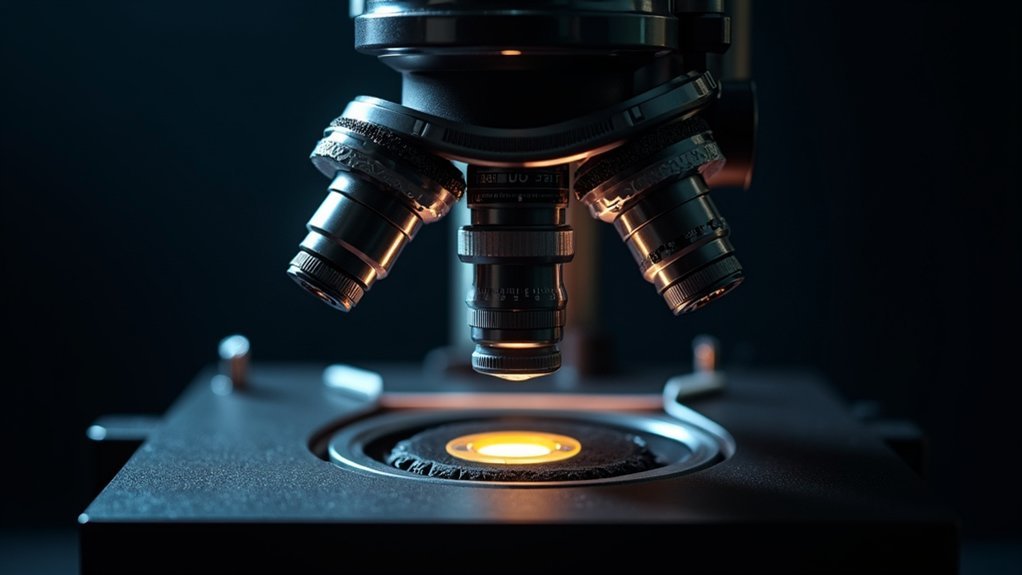
When arranging your darkfield microscopy setup, proper light path configuration becomes essential for achieving the striking contrast that makes this technique so valuable.
Start by selecting a dark-field condenser with high numerical aperture that matches your objective’s specifications—this guarantees ideal light transmission and superior contrast for small specimens.
Position your annular aperture precisely between the light source and condenser to create the characteristic ring-shaped illumination pattern.
You’ll need to perfectly center your condenser so the cone of light enters your objective lens accurately.
Don’t overlook the importance of using clean glass slides (1.1-1.2 mm thick) to minimize distortion.
Finally, incorporate bright light sources like LED lamps or fiber optic illuminators to enhance visibility of diffracted light, dramatically improving overall image quality and revealing specimen details invisible in brightfield microscopy.
Evaluating Immersion Options for High-Resolution Darkfield Microscopy
The choice of immersion medium dramatically impacts the quality and resolution of darkfield microscopy images. For best results, select oil immersion objectives with a numerical aperture of 1.25 or higher, as they provide superior light gathering capabilities compared to air or water alternatives.
Optimal resolution in darkfield microscopy demands oil immersion with numerical apertures above 1.25—nothing less will suffice.
When evaluating immersion options, consider these critical factors:
- Refractive index matching – Choose immersion oils that precisely match your objective’s optical properties to minimize light refraction and enhance clarity in imaging.
- Working distance requirements – Understand that oil immersion typically offers shorter working distances but delivers exceptional image quality for high-resolution applications.
- Objective design compatibility – Confirm your selected immersion medium aligns with the specific objective’s design specifications for best performance.
Always maintain clean slides when applying immersion oil to prevent distortion, especially with specimens smaller than 200nm.
Practical Techniques for Testing and Validating Objective Performance

After choosing your immersion options, you’ll need to verify your objective’s real-world performance. First, check that your darkfield objectives have a numerical aperture that meets or exceeds your condenser’s NA for ideal light collection and contrast enhancement.
Test with a standard specimen like suspended particles or live microorganisms to assess how well the objective reveals bright features against a dark background.
Ensure proper alignment between the darkfield condenser and objective lens to position the light cone effectively for superior imaging results.
For quantitative assessment, use specialized image analysis software to measure contrast and resolution of your images. This data helps compare different objectives objectively.
Don’t forget to clean your objectives and condenser regularly to prevent dust artifacts that can compromise your darkfield imaging quality.
Frequently Asked Questions
How to Choose a Microscope Objective?
Consider your objective’s numerical aperture for resolution, guarantee compatibility with your coverslip thickness, check magnification needs, evaluate correction type, and verify barrel markings. Higher NA values will give you finer detail in your images.
What Is the Difference Between Using 40X and 100X Objectives?
At 40x, you’ll get a wider field of view and better depth, while 100x requires immersion oil but offers superior resolution for tiny details like bacterial flagella down to 20nm in width.
How to Prepare a Slide of an Ideal Specimen for a Dark Field Microscope?
Choose a refractile, thin specimen on a clean 1.1-1.2mm slide. Apply immersion oil for high magnification. Confirm specimens aren’t too thick or crowded. Center your dark-field condenser properly to maximize light scattering against the dark background.
How to Differentiate the Objective Lenses?
You’ll differentiate objective lenses by checking their NA values, magnification markings, and specialized labels indicating whether they’re achromat, apochromat, or LWD objectives. Higher NA values offer better resolution for darkfield imaging.
In Summary
You’ve now learned how to select darkfield objectives that match your specific needs. By considering NA values, working distance, sample vessel compatibility, correction types, and immersion options, you’ll achieve ideal contrast and resolution. Remember to test your objectives with real samples before finalizing your selection. With these principles, you’re well-equipped to make informed decisions that’ll enhance your darkfield microscopy results.

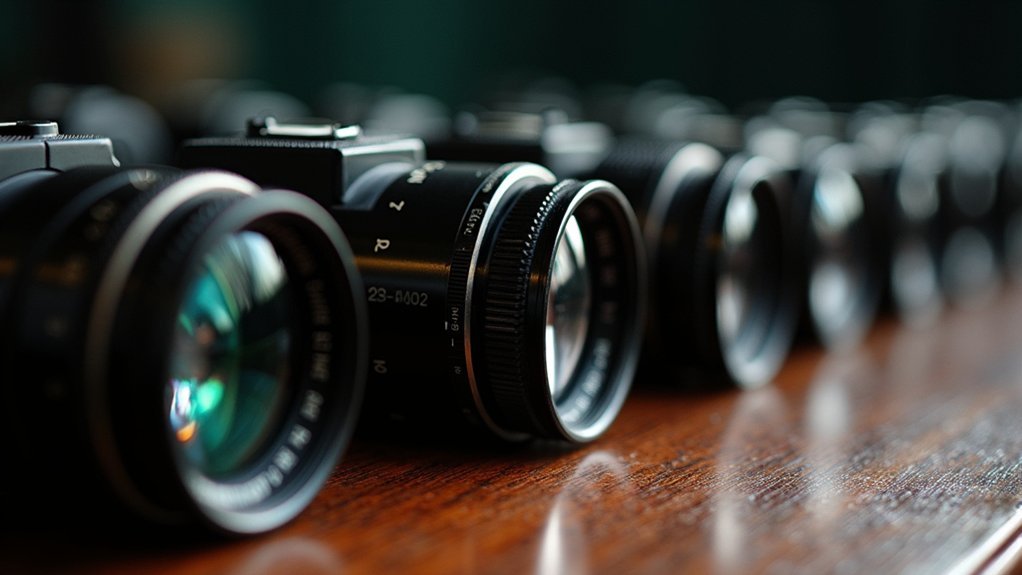



Leave a Reply